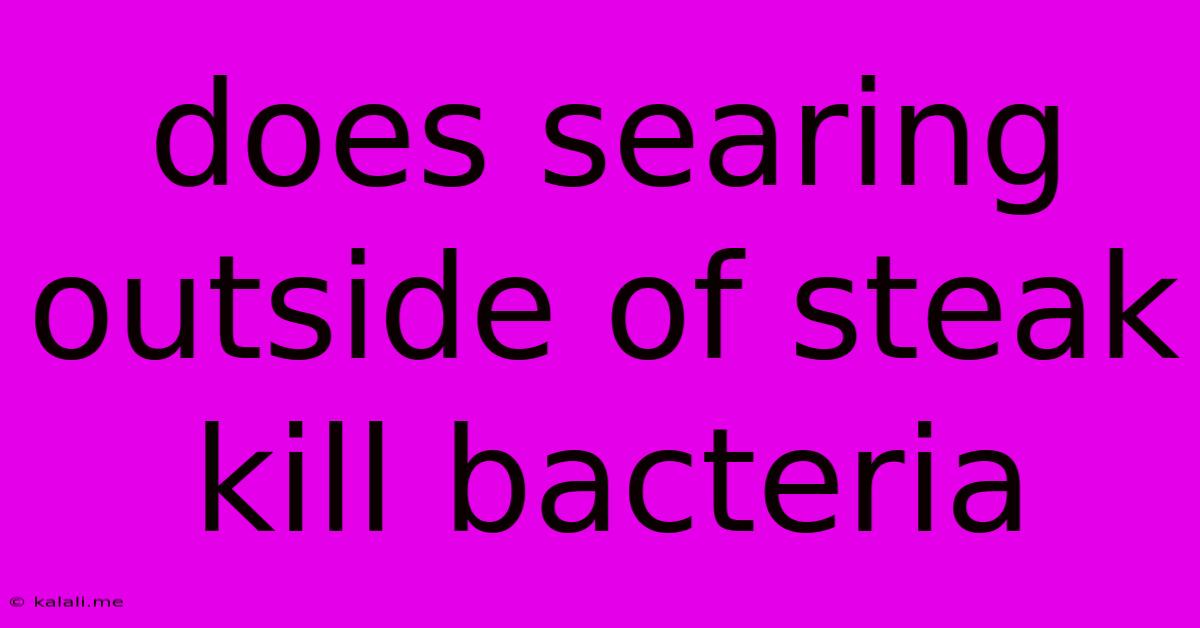Does Searing Outside Of Steak Kill Bacteria
Kalali
Jun 09, 2025 · 3 min read

Table of Contents
Does Searing a Steak Kill Bacteria? A Deep Dive into Food Safety
The satisfying sizzle of a steak hitting a hot pan is a hallmark of a delicious meal. But beyond the culinary appeal, many wonder: does searing a steak actually kill bacteria? The short answer is: partially, but not completely. This article delves into the science behind searing, exploring its effectiveness in eliminating harmful bacteria and highlighting crucial food safety practices.
Searing, the process of quickly browning food at high temperatures, creates a flavorful crust and desirable texture. While it does kill some bacteria on the surface of the steak, it's not a foolproof method of sterilization. The intense heat only penetrates a very thin outer layer, leaving the interior potentially harboring harmful microorganisms like E. coli or Salmonella. Therefore, relying solely on searing to ensure food safety is risky.
Understanding the Limits of Searing
The effectiveness of searing depends on several factors:
-
Temperature: A truly high heat (think screaming hot pan or grill) is crucial for achieving the Maillard reaction, responsible for the browning and flavor development. However, even at these temperatures, heat penetration is limited.
-
Time: Searing is a rapid process. While you aim for a good crust, prolonged searing won't significantly increase the depth of bacterial kill.
-
Thickness of the Steak: A thicker steak will naturally have more internal area untouched by the intense surface heat, leaving more room for bacteria to survive.
Beyond Searing: Essential Food Safety Practices
Searing alone is insufficient to guarantee a bacteria-free steak. To minimize the risk of foodborne illness, you must follow these crucial steps:
-
Proper Handling: Always practice good hygiene when handling raw meat. Wash your hands thoroughly before and after handling the steak. Avoid cross-contamination by using separate cutting boards and utensils for raw meat.
-
Safe Temperature: The only reliable way to eliminate harmful bacteria is by cooking the steak to a safe internal temperature. Use a food thermometer to ensure the steak reaches at least 145°F (63°C) for medium-rare, 160°F (71°C) for medium, and 170°F (77°C) for well-done.
-
Safe Thawing: Never thaw meat at room temperature. Thaw it safely in the refrigerator, under cold running water, or in the microwave using the defrost setting.
Searing's Role in a Safe Cooking Process
While searing won't eliminate all bacteria, it contributes to a safer cooking process in several ways:
-
Reduced Surface Bacteria: It does kill a significant portion of surface bacteria, thus reducing the overall bacterial load.
-
Improved Texture and Flavor: The browning and crust enhance the taste and texture, making the steak more appealing.
-
Faster Cooking: A good sear helps create a better crust, which can lead to faster and more even cooking.
In conclusion, while searing adds flavor and a delicious crust to your steak, it shouldn't be considered a primary method of eliminating bacteria. It's a supplementary step in a comprehensive food safety approach that prioritizes proper handling, safe cooking temperatures, and thorough thawing techniques. Always prioritize cooking your steak to a safe internal temperature to ensure your meal is both delicious and safe to eat.
Latest Posts
Latest Posts
-
Orange Discoloration On Macbook Pro Screen
Jun 09, 2025
-
What Does It Mean To Simplify In Math
Jun 09, 2025
-
Can People Who Speak Different Languages Sign To Each Other
Jun 09, 2025
-
Electrical Wiring Diagram 3 Way Switch
Jun 09, 2025
-
How Do I Get Ink Stains Out Of My Dryer
Jun 09, 2025
Related Post
Thank you for visiting our website which covers about Does Searing Outside Of Steak Kill Bacteria . We hope the information provided has been useful to you. Feel free to contact us if you have any questions or need further assistance. See you next time and don't miss to bookmark.